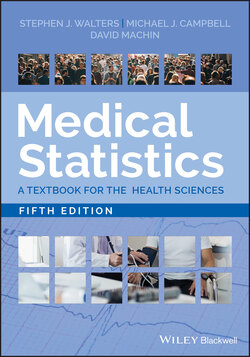Читать книгу Medical Statistics - David Machin - Страница 109
Worked Example – Reference Range – Birthweight
ОглавлениеWe can use the fact that our sample birthweight data, from the O'Cathain et al. (2002) study (see Figure 4.9); appear Normally distributed to calculate a reference range for birthweights. We have already mentioned that about 95% of the observations from a Normal distribution lie within 1.96 SDs either side of the mean. So a reference range obtained from this sample of babies is:
If the baby data were not Normally distributed then the normal reference range is obtained from the calculated percentiles of the sample as described in Chapter 2. Thus the 2.5 percentile corresponds to 2.5% of the babies below this weight which equals 2.91 kg. Correspondingly the estimated 97.5 percentile suggests that only 2.5% of babies are heavier than 4.43 kg at birth. The percentile‐based reference range for baby birthweight is therefore estimated to be 2.19 to 4.43 kg. This is very close to that obtained when we assume the birthweight has a Normal distribution.
Most reference ranges are based on samples larger than 3500 people. Over many years, and millions of births, the World Health Organization (WHO) has come up with a normal birthweight range for new‐born babies. These ranges represent results than are acceptable in new‐born babies and actually cover the middle 80% of the population distribution, that is, the 10th and 90th centiles. Low birthweight babies are usually defined (by the WHO) as weighing less than 2500 g (the 10th centile) regardless of gestational age, and large birth weight babies are defined as weighing above 4000 g (the 90th centile). Hence the normal birth weight range is around 2.5 to 4.0 kg. For our sample data, the 10th to 90th centile range was similar, at 2.75 to 4.03 kg.
